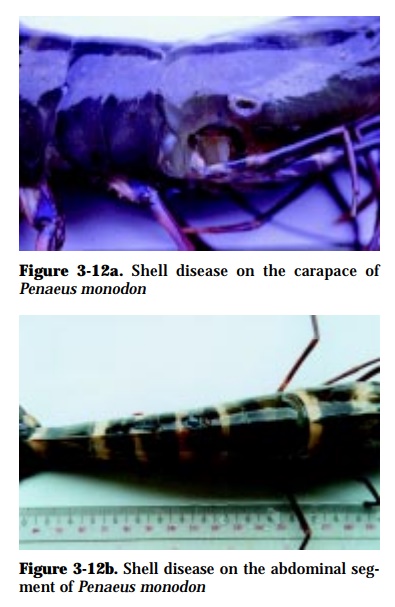Chapter: Health Management in Aquaculture: Bacterial diseases
Cuticular or Subcuticular Localized Infections - Bacterial Diseases of Crustaceans
Cuticular or Subcuticular Localized Infections
Shell Disease, Brown/Black Spot, Black Rot/Erosion, Blisters, Necrosis of Appendages
CAUSATIVE AGENT:
Shell-degrading bacteria belonging to Vibrio, Aeromonas, and Pseudomonas groups
Species affected:
Penaeus monodon, P. merguiensis, P. indicus
GROSS SIGNS:
The disease manifests itself as brownish to black, single or multiple, eroded areas on the general body cuticle (Fig. 3-12a, 3-12b), append-ages, and gills.

In larval and postlarval stages, the affected appendage shows a ciga-rette butt-like appearance (Fig. 3-13). Blister containing cyanotic ge-latinous fluid may develop on the carapace and abdominal segment. The blister may extend to the underside of the ventro-lateral section of the carapace creating a bulge on the underside.

EFFECTS ON HOST:
Infection usually starts at sites of punctures or injuries caused by the telson or rostrum, in cracks on the abdominal segment from sudden flexure of the shrimp body, or from other damage caused by cannibal-ism. Another infection site is the cuticle colonized by a large number of bacteria. The bacteria produce extracellular lipases, proteases, and chitinases, which together erode the multiple-layered cuticle, resulting in the development of the disease. The progressive destruction of the cuticle also provides a route of entry for secondary pathogens like fungi or opportunistic bacteria. Such infections may become lethal because of osmotic imbalances, molting problems, secondary fungal infection and a generalized septicemia. The affected shrimp becomes susceptible to cannibalism or dies from stress and energy exhaustion. The disease is associated with trauma to the cuticle (e.g. heavy aera-tion), conditions that encourage a high number of bacteria in the cul-ture water (e.g. poor hatchery hygiene, high organic loads or contami-nated algae) and undefined nutritional and environmental stressors.
DIAGNOSIS:
Diseased penaeids are examined for appearance of multifocal mela-nized cuticular lesions on the cuticle or the general body surface, the appendages, or the gills. Diagnosis may also be made by bacteriologi-cal (isolation, purification and identification) and serological (slide ag-glutination) methods.
PREVENTION AND CONTROL:
• Maintain good water quality and use nutritionally adequate diets.
• Keep organic load of the water at low levels by removing sediments which harbor high numbers of bacteria.
• Minimize handling and overcrowding and reduce other forms of stress.
• Avoid injuries to the exoskeleton of the shrimps to prevent the development of primary portals of entry.
• Induce molting, which eliminates the condition, but not when underlying tissues are damaged.
Related Topics